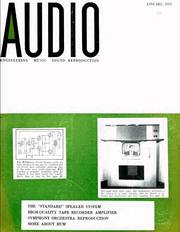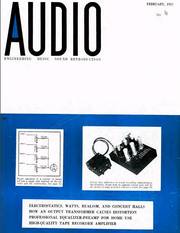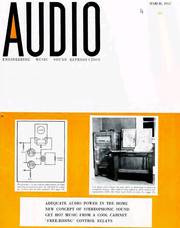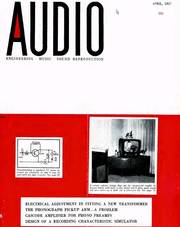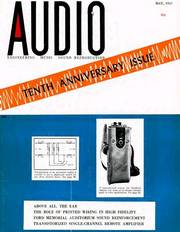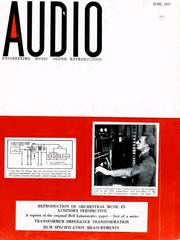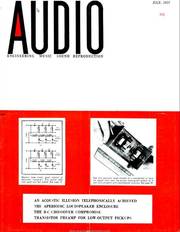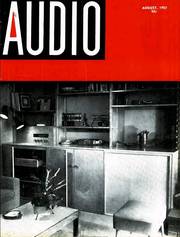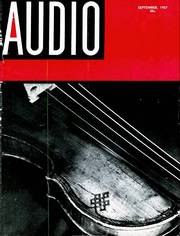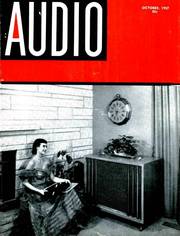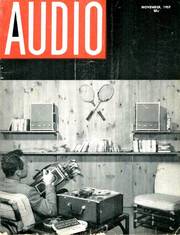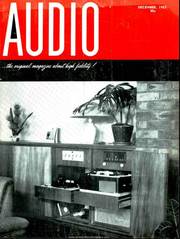Das (US) AUDIO "magazine" von 1947 bis zum Jahr 2000
Das amerikanische "AUDIO magazine" verwirrt uns Deutsche durch die Namensgleichheit mit dem deutschen Hifi-Magazin "AUDIO". Doch das amerikanische "AUDIO magazine" gab es schon Jahrzehnte früher. "AUDIO" zusammen mit "High-Fidelity" und "Stereo Review" gibt uns einen wunderbaren Einblick in den größten Hifi-Markt der Welt.
Ab 1959 sind die gedruckten Ausgaben der US-AUDIO eingescannt. Wir blicken auf etwa 240 Milionen Einwohner - auf 3 Zeitzonen verteilt - und das spiegelt einen Markt wieder, auf dem die eigentliche Hifi-Geschichte geschrieben wurde. Ein Blick in die edlen Wohn- zimmer der oberen 100.000 (= Hunderttausend !! - also nicht unserer "oberen Zehntausend") kommt immer wieder vor. - Auch ein historischer (Ein-) Blick auf und in die alten US-Gebäude, die damaligen US-Studios und die lustigen amerikanischen Büros und Werkstätten der US-Sender und Hersteller ist für uns historisch erhellend und erfreulich informativ.
.
(US) AUDIO Magazine 1957-05
Hier wird auf den 10 Jahrestag der Erstausgabe in 1947 hingewiesen. Damals verwirrend war, daß die Redaktion mit der Nummer 3 angefangen hatte und ich ganz mühsam die Ausgaben 1 und 2 gesucht hatte. Die gab es aber gar nicht.
.
(US) AUDIO Magazine 1957-12
Diese rare PDF Datei hat eine Text-Erkennungsrate von etwa 50%, das bedeutet alles sehr sehr genau Korrektur zu lesen und zu überarbeiten.
.
CONTENTS DECEMBER, 1957 VOL. 41, No. 12
.
- Audioclinic - Joseph Giovanelli
- Letters
- About Music - Harold Laivrence
- Comming Events
- Editor's Review
- The Stereo Recorder - A Revelation and an Education
- How To Plan your Hi-Fi System
- Impedance and Feedback in Audio Circuits
- The Sad Case of a Half-Watt Resistor
- Loudness, Its Definition, Measurement and Calculation, Part II
- Equipment Review
- Record Revue - Edward Tatnall Canby
- Audio ETC - Edward Tatnall Canby
- New Literature
- Jazz and All That - Charles A. Robertson
- New Products
- Industry Notes and People
- Annual Index 1957
- Advertising Index
.
COVER PHOTO
From "Down Under" comes this attractive arrangement created by A. E. Haydon & Wright, Ltd. Radio & Audio Engineers of 45 Victoria Street West. Auckland. .N. Y. The eqipment consists of a Philips AM tuner, Pye amplifier, Garrard chancer with Tannoy cartridge, a Tannoy 15" dual Concentric speaker (on opposite wall) and a Philips tape recorder - removable for portable use. The cane frame at the lower right ventilates the main amplifier.
.
EDITOR'S REVIEW
STEREO COMMENTS
WITH THE ALMOST CERTAIN CONVERSION of many thousands of home systems to stereo within the next year - both with existing tape equipment and with the coming stereo discs, we feel that some pertinent observations might be made. To date, we do not recall having seen any treatment of the importance of speaker phasing, yet the over-all quality of stereo reproduction depends greatly on this one condition.
To best observe this for oneself, it is only necessary to connect two speakers to a single amplifier, placing the speakers at a separation which would be normal for the listening room. Such a separation, we feel, would be somewhere in the vicinity of one-half the length of the shorter wall of the room, speakers being placed about one-fourth of the distance from each of the two adjoining walls. Then reproduce some well known selection through the two speakers, with the acoustic outputs adjusted to as near the same level as possible - by means of a pad in the more efficient of the two speakers.
When you listen to an arrangement of this sort, the sound should appear to come from a virtual speaker located half way between the two - in fact, we once told an exhibitor at a Montreal show that we would take the speaker in the center because it was so small. If you seem to hear both speakers when you are standing in front of them, it is almost certain that the speakers are out of phase. Then simply reverse the two leads to one of the speakers, not both. The sound should then appear to come from the center.
This solution would serve perfectly well if we were to use a single amplifier to drive the two speakers always, or even if we were to reproduce a monaural tape or disc through two amplifiers and speakers - once we had them connected properly we could assume that they would stay that way.
What happens, however, when we go to stereo tapes or discs. (For a description of the two stereo disc systems now being considered by record manufacturers, we suggest you read Mr. Carlson's letter on page 7.) Let us assume that we set up our system using a tape from a given manufacturer, and that we are completely satisfied with the results on that particular tape.
We then get some more tapes, and some sound good and some sound horrible, with little or no stero effect. Naturally, we would first blame the manufacturer for the poor tape quality.
On the other hand, it is likely that any record or tape manufacturer - and more and more of the former are becoming also the latter - who was trying to turn out good quality would have been satisfied as to his quality in his own studio and on his own system. However, he may be using two different types of amplifiers, one having one more stage of amplification than the other, and even though his inputs were properly phased (for two identical systems) his outputs would be out of phase. Can we assume that every manufacturer will make sure of his phasing by playing a full track recording across the two heads whenever he sets up a new system ? Can we be sure that the phasing will remain constant through the various systems used in making multiple copies of the master tape?
Let us consider another possibility. Suppose we have a system which we set up (without being aware of the possible pitfalls in phasing) with a specific pair of amplifiers and speakers. Then we change amplifiers or speakers, and we find out, that nothing sounds right after the change. If we are aware of this problem, we can change speaker connections and everything will be satisfactory again. On the other hand, there is nothing we can do to ensure that every stereo tape or record is phased exactly right for our own particular system.
There is a cure, however - not automatic, to be sure, but certainly one which will allow us to make a check whenever we hear a tape or disc that does not sound just right. We feel that EVERY stereo system should be set up with a reversing switch on one of the speakers. This would make it possible to check every time we were not satisfied with the sound.
All that is required is a simple double-pole, double-throw switch. In our own installation this is mounted on the back of the speaker housing, readily accessible from the top. It is likely that there will be some standardization of phasing at some future date, but until then we find the phasing switch most useful.
AUDIO • DECEMBER. 1957
Briefe and den Herausgeber
Stereo Discs
(The following is an excerpt from a letter by Ruben K. Carlson, vice-president of Fairchild Recording Equipment Company to its dealers and representatives. It docs such a clear job of describing the two methods of cutting stereo discs that it is believed that, readers will find it instructive and interesting. The Editor)
Zur Zeit (Herbst 1957) sind 2 Stereo Konzepte entwickelt
... There are two systems at present competing: the first of these is the WESTREX so-called 44-45 system, and the second is the LONDON Vertical-Lateral system. We were privileged to attend demonstrations of both of these and to inspect very closely all aspects of both.
It is encouraging to note that everyone seems determined not to make any stereo records before adopting an industry-wide standard method, since all are anxious to avoid the errors of the past in connection with LP's and 45's.
This is the attitude of both Westrex and London, and we know of very few new developments which have been approached so sanely.
Das LONDON System
In the LONDON system of recording, the two channels are fed to a specially designed cutter in which the cutting stylus moves vertically for one channel and laterally for the other.
The groove is therefore a complex engraving in three dimensions, having vertical and lateral components representing each individual channel, and the record has a most peculiar appearance because of the shape of the modulation.
The playback cartridge (their experimental model was a variable reluctance type) is so designed that a lateral component affects one of two separate pickup coils, and a vertical component affects the other coil.
There are, therefore, three leads from the pickup, one being a common ground. The two signals are fed through two independent, amplifier and speaker systems. Of the two demonstrations, the London system exhibited slightly better sound.
It was the general opinion that this was not inherent in the system but was rather due to a better prototype pickup in the ease of the London system. There are certain inherent disadvantages in vertical recording which are well known (pertaining to distortion and dynamic range in particular) which would seem to be an argument, against this system. We must say, though, that the London sound was excellent.
Das WESTREX System
The WESTREX system is a little harder to understand without actually seeing and handling a model of the cutter, as we were privileged to do.
The idea is, however, that the cutter is designed so that there are two driving rods attached to the cutting stylus, each of these comming down to an angle of 45° from the vertical and forming a "V" with 90° included in the "V".
These driving rods are attached to moving coils set higher up in the cutter, and the stylus is supported on a rather long cylindrical tube running horizontally (and perpendicular to the plane of the driving rods).
Either moving coil alone will therefore move the stylus up and down along a slanted line at 45° to the verticle. If both coils operate together and in phase, the stylus will be pushed equally and will move up and down vertically. If both coils operate together but out of phase, the stylus will be pushed only sidewise or laterally.
Since each coil is connected to a separate channel, a 45° slantwise motion corresponds to one channel, and either vertical or lateral motion has information for both channels.
Die Mono Kompatibilität wäre das schlagende Argument
For this reason, the 45-45 system achieves complete compatibility for standard microgroove (mono) records and this is felt to be very important. That is, the WESTREX system enables playing of stereo discs monaur-ally with a standard LP cartridge, or binaurally with a stereo cartridge; also, the stereo pickup will play standard LP discs monaurally, as well as stereo discs binaurally. The user can make the transfer partially or completely and without making obsolete any of his present records or equipment.
Of course with any stereo system, including the Westrex, two amplifiers and preamplifiers, and two speakers are needed for stereo results. The Westrex cutter is also compatible and will cut either 45-45, vertical-lateral, or regular LP records, so we are in the fortunate position that both principal parties are willing to adopt the system best suited to the public's need.
Ruben E. Cakuson - AUDIO • DECEMBER, 1957
.


